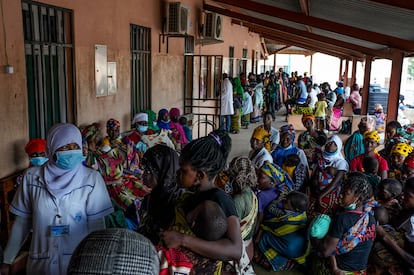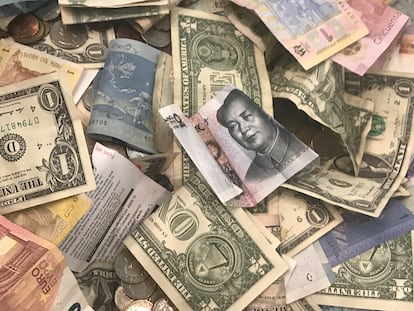The Nyerere question: ‘Should we really let our people starve so that we can repay our debts’
African countries face significant financial burdens that limit their ability to invest in social programs. Restructuring and other financial instruments will be key topics at the 4th International Conference on Financing for Development in Seville

Forty years ago, in the midst of Africa’s debt crisis, Tanzania’s then president, Julius Nyere, asked his country’s creditors a stark question: “Should we really let our people starve so that we can repay our debts?” He didn’t get the answer he was looking for. Instead of cutting Africa’s debt, western governments slashed their aid budgets, consigning Africa to a lost decade of deepening poverty and hunger.
The “Nyerere question” hangs like a cloud over the U.N. finance for development summit, which opens next week in Seville.
Debt has re-emerged as a powerful brake on human development. The IMF estimates that 35 out of 68 low-income countries are either in, or at risk of, debt distress. With aid budgets in freefall, governments across the world’s poorest countries are once again being forced to choose between repaying creditors and investing in the health, education, and nutrition of children.
This year, governments in Africa are scheduled to spend $88 billion servicing their debt. That’s more than they spend on health, nutrition, and basic education combined. This is in a region where one-in-five people live with the grinding reality of hunger and 237 million children are being raised in extreme poverty. Debt repayments are crowding out the public investments needed to combat malnutrition, improve child and maternal health, and tackle an education crisis that threatens long-term prosperity.
Twenty years have passed since the Heavily Indebted Poor Countries (HIPC) Initiative brought down the curtain on the debt crisis that troubled Julius Nyerere. So why are we living through a debt Groundhog Day? In the aftermath of HIPC, many governments borrowed heavily from commercial sovereign bond markets, taking advantage of a commodity boom and low interest rates. Tightening global monetary conditions, surging interest rates, and a post-pandemic slowdown in economic growth tipped one country after another into crisis as debt service obligations spiralled.
Failure to develop a comprehensive debt relief plan reinforced the crisis. While HIPC covered debts owed to the IMF, World Bank and bilateral creditors, there is no framework for reducing the commercial debts owed to sovereign bondholders who now account for over 40% of Africa’s debt service payments, or to China — now Africa’s biggest bilateral lender.
In a desperate bid to avoid default, governments have been forced to refinance debt by issuing new bonds that carry a hefty risk premium. Last June, Kenya issued $2bn in new bonds to pay off debts falling due at an interest rate of 10%. Repaying those bonds will require sustained austerity, reinforcing already deep cuts in budgets for health and education. Others — including Ethiopia, Zambia, and Ghana — have defaulted and are going through painful debt restructuring.
The G20’s Common Framework remains the closest thing we have to a multilateral debt relief arrangement. But in the words of a recent ODI Global report, it offers ‘too little, late.’ It took Zambia almost four years to secure a debt restructuring agreement as the country’s creditors — mainly private bondholders and China — argued over their respective claims. Meanwhile, public spending was cut by one-fifth.
Debt reduction is a vital component of any strategy aimed at delivering affordable finance at the scale needed to accelerate progress towards the 2030 Sustainable Development Goals. Converting current debt service liabilities into investments in future generations would transform millions of lives — and there is a precedent. The HIPC Initiative wrote off over $100 billion in debt stock, most of it owed to the IMF and World Bank, enabling governments to invest an additional 4% of national income in poverty-related spending. We need a similar level of ambition for today’s debt crisis.
Debt swaps can also play a role. These are arrangements under which creditors provide debt relief in return for a government commitment to use all or part of the savings for investment in priority areas.
Reducing commercial debt can require complex financial engineering. The typical arrangement involves some combination of creditor agencies providing guarantees for new bond issues at lower interest rates, enabling governments to “buy-back” high-interest debt and save money. In recent years, large-scale commercial debt swaps have been dominated by marine conservation in countries like Ecuador and Barbados.
The World Bank has now replicated that model while cutting the complexity. Using its own guarantees, it has enabled Côte d’Ivoire to issue new bonds and repurchase high-interest debt. The money saved — around $60 million annually — will be directed to education.
In the case of bilateral debt owed to aid agencies, the swap mechanisms are disarmingly simple. Spain has acted as a pioneer. Its Debt2Health program has written off debts to finance the Global Fund to Fight HIV/IDS, Malaria, and Tuberculosis. Other donors — including Italy and Germany — have financed debt-for-food swaps through the World Food Programme.
Even as they cut aid programs, donors could deliver more ambitious debt swap agreements. That will require a revision of OECD rules, which limit the scope for swapping debts owed to bilateral aid agencies. It will also take a commitment to problem-solving.
Consider the case of Somalia. The government wants to use a debt swap with Spain to help finance a national school feeding program that could transform millions of lives. Under Spanish debt swap practices, the Treasury can cancel 60% of bilateral aid debts outright, but the debtor country needs to finance the remainder — in this case $16 million — into a special trust fund. Somalia lacks the finance, which has held up progress, but the IMF-World Bank has a facility which could make the payment, unlocking finance that could transform the lives of many children in Somalia. Doubtless there are tough questions to be addressed. But ‘just do it’ should serve as a guide to action.
There should only be one answer to the Nyerere question. Allowing the claims of private creditors to rob a generation of children of their health, education, and hope is morally indefensible and economically short-sighted. It points to something rotten in the state of global economic governance — and it is time to stop the rot.
Sign up for our weekly newsletter to get more English-language news coverage from EL PAÍS USA Edition
Tu suscripción se está usando en otro dispositivo
¿Quieres añadir otro usuario a tu suscripción?
Si continúas leyendo en este dispositivo, no se podrá leer en el otro.
FlechaTu suscripción se está usando en otro dispositivo y solo puedes acceder a EL PAÍS desde un dispositivo a la vez.
Si quieres compartir tu cuenta, cambia tu suscripción a la modalidad Premium, así podrás añadir otro usuario. Cada uno accederá con su propia cuenta de email, lo que os permitirá personalizar vuestra experiencia en EL PAÍS.
¿Tienes una suscripción de empresa? Accede aquí para contratar más cuentas.
En el caso de no saber quién está usando tu cuenta, te recomendamos cambiar tu contraseña aquí.
Si decides continuar compartiendo tu cuenta, este mensaje se mostrará en tu dispositivo y en el de la otra persona que está usando tu cuenta de forma indefinida, afectando a tu experiencia de lectura. Puedes consultar aquí los términos y condiciones de la suscripción digital.
More information
Archived In
Últimas noticias
Most viewed
- Reinhard Genzel, Nobel laureate in physics: ‘One-minute videos will never give you the truth’
- Oona Chaplin: ‘I told James Cameron that I was living in a treehouse and starting a permaculture project with a friend’
- Pablo Escobar’s hippos: A serious environmental problem, 40 years on
- Why we lost the habit of sleeping in two segments and how that changed our sense of time
- Chevy Chase, the beloved comedian who was a monster off camera: ‘Not everyone hated him, just the people who’ve worked with him’










































